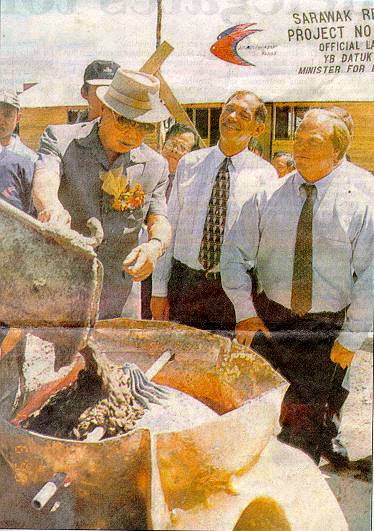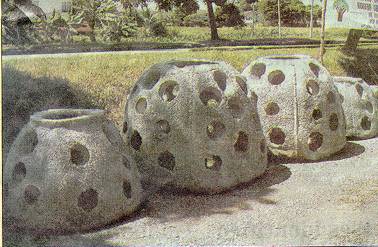With permission, from "The Borneo Post", Front Page, Thursday, June 18, 1998
Reef Ball project to protect turtles
KUCHING, WED. Special 'mines' will be strewn at random on the sea floor around Talang-Talang and Satang Islands to deter fishing trawlers from practising illegal trawling activity there.
These environmental-friendly and non-toxic "Reef Balls" are part of the measures adopted by the State government to give some protection to the turtles around the Islands, said Environment and Public Health Minister Datuk Amar James Wong Kim Min.

The Minister (L) being shown how the Reef Balls are moulded
by Harry Rolfe (C) and Larry Beggs (R) of the Reef Ball Development Group of
the United States
Speaking when officially launching the "Sarawak Reef Ball Working Group" Project I (Talang-Talang Region) this morning, he said Sarawak is the first Asian country to use the reef balls and it could be a model for the rest of Asia in planned and responsible marine conservation.
The Reef Balls are invented and manufactured by the Reef Ball Development Group Limited of the United States, a non-profit organisation helping to restore the world's ocean ecosystem. Wong said the sea turtle population has declined at an alarming rate of 95 percent over the last 35 years.
The species of marine turtles found in Sarawak are the Green Turtle, the Hawksbill and the Olive-Ridley and their populations have stabilized recently showing that past conservation efforts are beginning to bear fruit.
"Illegal fishing trawling activity is the largest culprit responsible for killing so many turtles and patrols against such activities are not effective at all. The truly effective way to deter these illegal trawlers is to seed the sea bed around the Islands with some artificial barriers that will act as "mines" to rip their nets apart. This is a more effective as a deterrent measure of enforcement rather than "band aid' tactic of trying to catch them after they have entered the protected areas and may have already killed one or more turtles."
In the past, old car bodies and cement structures were used but such artificial barriers contain heavy metal toxins and chemicals that can kill marine life.
They are also not stable on the sea bed, being tossed around like pebbles clue to the strong wave action and the currents.
The Reef Balls, on the other hand, are constructed from Fiberglass molds using cement with the same pH as salt water and containing admixtures and micro silica.
They remain stable on the sea bottom even in hurricanes as the materials used are dense, of moderate to low profile and designed in such as way that more than half of its weight is in its bottom on the sea floor.

The Finished Reef Balls
They have a variety of rough surface textures and they will effectively cut any trawler's nets when they are caught up by the trawler.
They also have holes in them to create vortexes, and the large space in the centre provides shelter for the fish while the surfaces enhances the settlement of marine life.
The reef balls are expected to last at least 500 years and will hopefully help put the population of marine turtles to full recovery by the year 2010.
Manufacturing of the Reef Balls have started, with each reef ball requiring 28 days for the cement to cure fully and 300 balls will be ready for laying within the next two months. This will be followed a month later by another 200 balls.
The Group will then conduct a scientific survey to study the effectiveness of the first project before embarking on a follow-up project a year later.
The ministry will fund the initial project costs of RM300,000, Wong disclosed. He however appealed to companies and corporate bodies to sponsor the materials for subsequent reef ball projects, so that the areas of coverage can be extended to other marine parks.
Meanwhile, Wong said it was not the intention of the State government or the Forestry and Wild Life Department to make life difficult for the trawlers as the reef balls are only meant for areas like Talang-Talang and Satang Islands, or other areas which needed protection in order to conserve marine wildlife, particularly the turtles.
"The trawlers still have a big area of the open sea where they can trawl, so we are not endangering their livelihood." he said. -BP